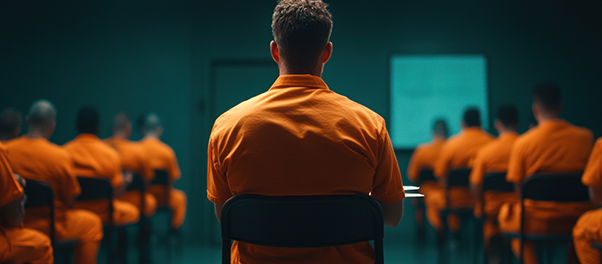- The Scope of the Problem
- The Magnitude of Serious Mental Illness in U.S. Jails and Prisons
- Alternative to Incarceration and Prison Reform
- Successful Models and Advocacy
- Moving Forward
- Comprehensive Overview of Correctional Mental Health System
- Funding and Administration
- Legal Considerations
- Ideas for Reform
- Additional Resources:
The Scope of the Problem
Many individuals with psychiatric problems end up in the arms of the law due to untreated symptoms that lead to criminal behavior. According to the Treatment Advocacy Center, individuals with severe mental illness are ten times more likely to be incarcerated than hospitalized, highlighting the systemic failure to provide appropriate community care. Once incarcerated, these individuals can face harsh environments, isolation, and limited access to care, leading to worsening symptoms.
The Magnitude of Serious Mental Illness in U.S. Jails and Prisons
People with serious mental illness (SMI) are disproportionately incarcerated. While 6% of U.S. adults have a serious mental illness, their prevalence in correctional facilities is estimated to be three to four times higher. Los Angeles County Jail, Cook County Jail in Chicago, and Riker's Island Correctional Facility in New York house more individuals with mental illnesses than any psychiatric hospital in the U.S. Accordingly, 20% of jail and 15% of state prison inmates are diagnosed with a serious mental illness. This translates to roughly 383,000 inmates, nearly 10x the number of patients in state psychiatric hospitals.
Alternative to Incarceration and Prison Reform
Effective reform should focus on transitioning or diverting people with mental health issues out of and away from the legal system and into treatment. Initiatives such as crisis intervention and assertive community treatment teams can help individuals obtain care rather than incarceration.
Improving access to mental health services within prisons, training staff to recognize and respond to psychiatric crises, and implementing re-entry programs that include mental health support are crucial steps toward reducing recidivism and promoting public safety.
Successful Models and Advocacy
Programs like the Sequential Intercept Model offer a framework for preventing people with mental illness from entering or remaining in the criminal justice system. Advocacy groups such as the National Alliance on Mental Illness (NAMI) and the Sentencing Project work tirelessly to promote policies that support mental health care and humane treatment for incarcerated individuals.
Moving Forward
Mental health reform in prisons is not only a moral imperative but also a practical one. By prioritizing treatment over punishment, a more just and effective system can be created that supports and reduces re-offense and ultimately benefits society.
Comprehensive Overview of Correctional Mental Health System
Mentally ill adults often become involved in the criminal justice system due to inadequate mental health support. Programs like crisis response training and mental health courts aim to divert them from deeper involvement. However, when diversion fails, they end up in jails and prisons.
Phases of Correctional Mental Health Care:
- Booking/Intake:
- Competency evaluation for charges
- Diagnosis, including substance abuse
- Classification for safety and housing needs
- Confinement:
- Medication management and adjustments
- Psychosocial interventions like dialectical behavioral therapy
- Advocacy and behavioral remediation
- Discharge:
- Connection to community-based mental health programs
Funding and Administration
Correctional mental health care funding comes from government budgets, not federal programs like Medicaid or Medicare. The shift from state-funded asylums to county-funded jails and prisons has strained local resources. Recruitment challenges and inadequate infrastructure further complicate care delivery, particularly in rural areas. Telehealth and increased training have addressed these gaps, but systemic inefficiencies remain.
Legal Considerations
Incarcerated individuals have a constitutional right to mental health care under the Eighth Amendment, particularly for serious mental health needs. Legal rulings, such as Estelle v. Gamble, mandate care to prevent "cruel and unusual punishment." However, systems are not obligated to treat milder disorders unless they are linked to competency or safety concerns. Consent decrees and lawsuits have improved in some areas, but progress is inconsistent.
Ideas for Reform
- Prioritize Mental Health Treatment: Provide 24/7 access to mental health care, including evidence-based therapies like cognitive behavioral therapy (CBT).
- Increase Funding: Governments should support correctional facilities providing mental health care, especially for serious conditions.
- Improve Data Collection: Accurate mental health prevalence and outcomes data is crucial for effective policy-making.
- Address Disparities: Implement culturally competent and trauma-informed care for racial and ethnic minorities.
- Expand Psychiatric Services: Repeal Medicaid’s Institutions for Mental Diseases exclusion to increase access to psychiatric beds and reduce the burden on jails.
- Create Specialized Units: Establish secure mental health step-down units for inmates with serious mental illnesses and a history of violence.
- Optimize Discharge Plans: Use long-acting medications during discharge to ensure continuity of care. Work with local mental health providers to provide quality care for incarcerated individuals.
- Support Reentry: Provide transition support programs and therapies to help inmates reintegrate into the community. Fund employment models that assist individuals with mental health disabilities find and retain jobs.
- Reduce Solitary Confinement: Invest in mental health housing and rehabilitation units to minimize the need for isolation.
Addressing the needs of seriously mentally ill individuals in correctional settings is essential for reducing recidivism, improving community safety, and upholding humane treatment standards. Effective reform will require coordinated efforts across government, healthcare, and community systems.
Additional Resources:
Blog Post
- Unlocking Wellness Behind the Bars: Illuminating the Struggles and Triumphs of Mental Health in Prisons
- Destigmatizing Mental Health in Prisons
Research
- Burnout and Empathy in high-stress mental health settings
- Unlocking Meaning: Metacognition as Key to Incarcerated Persons' Mental Health Recovery
Training
Podcast






















